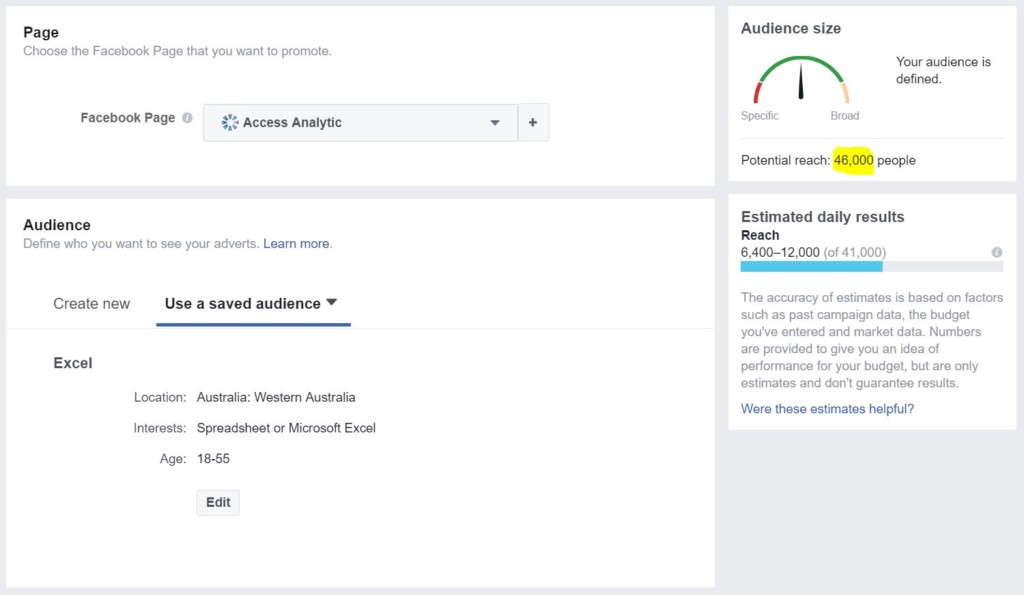
Power BI data sources can be almost any file, database or web service.
Here’s an innovative way to use this amazing connectivity to estimate your market share using free information sources from the web.
Facebook tells me my Market Size
If you’ve ever placed an ad on Facebook, you’ll know the incredible range of characteristics it lets you specify when setting your target audience:
- Location: country, region, city, suburb and within x km (or miles) of this.
- Age range: max & min.
- Gender.
- Relationship status (it’s complicated!)
- Interests.
- Life events.
- etc
This is fantastic for advertisers as they can target their ads to just the right people who are interested in whatever it is they’re selling.
Maybe this article is why I’m now seeing so many ads about advertising on Facebook!
To help you decide how much money you want to spend with Facebook, it provides an incredibly useful number, just before you click “Place ad”:
the Potential Reach estimate.
This can be one of your Power BI data sources!

If I know how big my potential market is, I can easily combine this with customer data from my CRM and estimate my market share.
Power BI Data Sources for Digital Demography
There is now an emerging area of study around this area, called “Digital Demography“, being pioneered by Bogdan State (Stanford) and Ingmar Weber (Qatar Computing Research Center).
The idea behind it is simple: we tell online services like Google, Facebook, LinkedIn, Twitter and our e-mail servers virtually everything there is to know about us.
This provides demographers and marketers with an online, ongoing, constantly updated census that tells us all about vast populations of people.
Rather than taking a census once every 4 years (as is done in Australia), then waiting for another year for the results to be collated and released, the online world provides a snapshot of this data immediately, whenever we require it.
All we need to do is tap into this!
Facebook very kindly provides us with access to its free Marketing API.
With a little coding, this can be used as one of your Power BI data sources to automatically provide a constantly updated estimate of your specific target market size and market share.
Facebook won’t provide you with details of who the people are of course. You need to pay Facebook some cash to advertise to your target market. However, Facebook will tell you how many people match your criteria … for free!
You could use this in cases such as:
- Monitoring how your product or service is going in the market
- Researching locations to open a new store by checking how many people within a radius of 5km share a particular interest
- Checking how many people in Perth are interested in holidays in Europe (for airlines, tourism agencies etc)
- Monitoring interest in a competitor within your target market
Unfortunately, Facebook’s API only provides your market share at the time you do the query. It doesn’t tell you how this changes over time. However, we can also do this via Power BI by storing the results automatically each day.
The following example URL string returns JSON code which Power BI can read. It counts how many people there are on Facebook in the US, aged 25 years and over, and located within San Francisco (city code 2430536). Just URLDecode the targeting_spec below to see how this works.
https://graph.facebook.com/v2.8/act_/reachestimate?currency=USD&optimize_for=OFFSITE_CONVERSIONS&access_token=&targeting_spec=%7B%22age_min%22%3A25%2C%22geo_locations%22%3A%7B%22cities%22%3A%5B%7B%22key%22%3A2430536%7D%5D%7D%7D
Google Trends
Google also provides an incredibly useful free tool for researching search trends and topics called Google Trends.
You can use this to check the relative search popularity for keywords or topics you’re interested in. You can even compare multiple search terms to each other to see how popular each one is compared to the other.
You can then export all the data to CSV manually if you’re signed into Google.
The popularity of the “Power BI” search term over the last 5 years:

Like some help?
If you don’t want to learn all the technical ins and outs of making this work, just leave your details below and we’d be happy to help.







